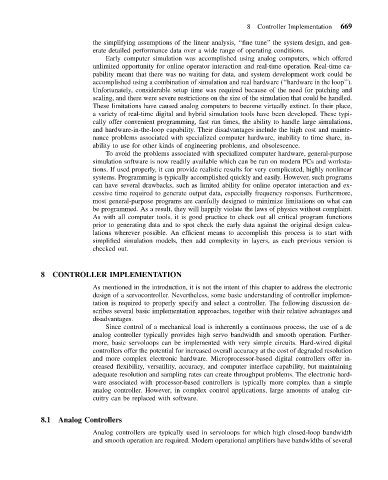Page 678 - Mechanical Engineers' Handbook (Volume 2)
P. 678
8 Controller Implementation 669
the simplifying assumptions of the linear analysis, ‘‘fine tune’’ the system design, and gen-
erate detailed performance data over a wide range of operating conditions.
Early computer simulation was accomplished using analog computers, which offered
unlimited opportunity for online operator interaction and real-time operation. Real-time ca-
pability meant that there was no waiting for data, and system development work could be
accomplished using a combination of simulation and real hardware (‘‘hardware in the loop’’).
Unfortunately, considerable setup time was required because of the need for patching and
scaling, and there were severe restrictions on the size of the simulation that could be handled.
These limitations have caused analog computers to become virtually extinct. In their place,
a variety of real-time digital and hybrid simulation tools have been developed. These typi-
cally offer convenient programming, fast run times, the ability to handle large simulations,
and hardware-in-the-loop capability. Their disadvantages include the high cost and mainte-
nance problems associated with specialized computer hardware, inability to time share, in-
ability to use for other kinds of engineering problems, and obsolescence.
To avoid the problems associated with specialized computer hardware, general-purpose
simulation software is now readily available which can be run on modern PCs and worksta-
tions. If used properly, it can provide realistic results for very complicated, highly nonlinear
systems. Programming is typically accomplished quickly and easily. However, such programs
can have several drawbacks, such as limited ability for online operator interaction and ex-
cessive time required to generate output data, especially frequency responses. Furthermore,
most general-purpose programs are carefully designed to minimize limitations on what can
be programmed. As a result, they will happily violate the laws of physics without complaint.
As with all computer tools, it is good practice to check out all critical program functions
prior to generating data and to spot check the early data against the original design calcu-
lations wherever possible. An efficient means to accomplish this process is to start with
simplified simulation models, then add complexity in layers, as each previous version is
checked out.
8 CONTROLLER IMPLEMENTATION
As mentioned in the introduction, it is not the intent of this chapter to address the electronic
design of a servocontroller. Nevertheless, some basic understanding of controller implemen-
tation is required to properly specify and select a controller. The following discussion de-
scribes several basic implementation approaches, together with their relative advantages and
disadvantages.
Since control of a mechanical load is inherently a continuous process, the use of a dc
analog controller typically provides high servo bandwidth and smooth operation. Further-
more, basic servoloops can be implemented with very simple circuits. Hard-wired digital
controllers offer the potential for increased overall accuracy at the cost of degraded resolution
and more complex electronic hardware. Microprocessor-based digital controllers offer in-
creased flexibility, versatility, accuracy, and computer interface capability, but maintaining
adequate resolution and sampling rates can create throughput problems. The electronic hard-
ware associated with processor-based controllers is typically more complex than a simple
analog controller. However, in complex control applications, large amounts of analog cir-
cuitry can be replaced with software.
8.1 Analog Controllers
Analog controllers are typically used in servoloops for which high closed-loop bandwidth
and smooth operation are required. Modern operational amplifiers have bandwidths of several

